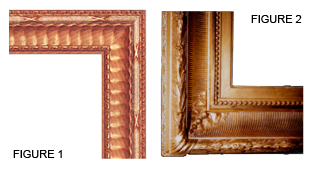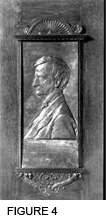Frame Replica Article
by Eli Wilner & Company Period Frames, NYC Copyright © March 1994
Reproductions or Exact Replica Frames?
Learning to see the Difference
Many people today have little idea of the wide gulf between the reality of historical frame design and the currently manufactured reproduction frames. Many, in fact, don’t even realize that many of the frame styles made today are many times removed from earlier period frames. As the awareness of period frame styles and their vital role in art history becomes more widely acknowledged, it is important that this disparity be known. This is not to say that current repro frames have no place in today’s marketplace; only to point out the importance of recognizing the difference and of making an informed aesthetic choice when framing valuable works of art.
The difference between what repros look like today and how the historical original appears can be seen in the complex and intricate designs of the 19th century. The use of applied composition decorations (compo) eliminated the laborious process of hand carving and provided a way to create sophisticated and elaborate designs. While the use of compo was disparaged at the end of the 19th century as a loss of craftsmanship, the truth is that even though molded, 19th century compo decorations are often astoundingly detailed. The precision with which they are rendered is rarely seen in the mass manufactured frames made today.
Much like the game of “telephone” we played as children, historical frame designs have been increasingly debased over time. Many reproduction frames today are made using molds and patterns many times removed from the original, and often by factory workers who have little or no exposure to the period frame they are trying to recreate (Figures 1 and 2).
Aside from the obvious area of profile and decorative ornamentation, there are very specific subtleties in the gold leaf surfaces throughout the 19th and early 20th centuries. It is not unusual to see one type of gilding and patina in the 1830’s, another quite different in the 1850’s, and yet another unique, though still gilded, finish in the 1880’s. Subtleties such as these are of growing consequence as the importance of the artwork being framed increases and as the person requesting the frame is more sensitized to these nuances. Connoisseurship no longer stops at the edge of the canvas; many curators, collectors, and dealers now give great thought and attention to the historical appropriateness of frame style and finish.
Fine replica frames are made using the same processes used in creating the original; carved frames are carved, frames with compo ornament are used to make molds and the replica is created with applied ornament. A good frame reproduction house will have an extensive inventory of original period frames used as a literal reference library of frame styles and finishes to enable the craftspeople to work with the original throughout the replication process. This allows them to match crisp ornamental detail and patinated gilded surfaces in a way that far surpasses conventional reproduction frames.
Although the use of a period frame is always the preference, there are situations when an exact replica may be selected. One case may be when a pair of paintings is being framed and only one period frame is available. With one original, molds can be made (or a pattern, if the original is carved) of the original and a mate created to match it. The final gilding and surface toning of the replica should match the finish of the original as well. Another consideration may be the price; if the cost of a period frame is more than the budget allows, usually an appropriate frame can be selected and replicated for less. (There can be exceptions when it is more costly to replicate a period frame due to tremendous complexity of the design.)
Another situation when replication may be appropriate is when a frame is simply not available at any cost. At the National Museum of American Art in Washington, D.C., the recent acquisition of a painting by John Singleton Copley presented such a dilemma. Copley is known to have selected a specific style of frame for paintings done at the time the portrait was painted. The style of frame in question was nearly impossible to locate, however once it was located, the style did not lend itself well to an alteration of size. Thus the curator located another Copley in its original frame, in the Nelson Atkins Museum. A replica frame was then carefully handcarved and gilded to match that found on the other portrait (Figure 3).
In another case, a collector needed a frame for a relief by Augustus Saint-Gaudens. Knowing that Saint-Gaudens frequently used frames designed by Stanford White for his reliefs, a White-designed frame on a Saint-Gaudens’ relief in the collection of the Metropolitan Museum of Art was used as the design of choice and a replica of the same style carved for the second relief
Yet another reason for replication is when a large portion of the original frame is missing. At the Metropolitan Museum of Art the painting “Banks of the Loing” by William Lamb Picknell had long been exhibited in what remained of the original frame – its inner liner. This is often seen in museums where the large outer element of a frame has been removed due to damage and then lost or discarded over time. The curator reviewed several different outer elements, which were all historically correct for the painting and selected one.
The outer section was replicated from an original frame and made to go around the original liner to create a complete frame. The outer element was then carefully toned to match both the liner and the original frame that had been replicated. The painting is now enclosed in a frame that reflects the period, enhances the painting, and amplifies the perspective of the composition.
When attempting to frame an important painting in a style that is historically correct, seek a frame that is worthy of the art it will enclose. If a replica frame is the choice, be sure to select a frame that displays all the attention to detail and subtleties of finish that an original period frame does. Look for meticulous rendering of ornament and sensitivity in the gilding and toning. Educate your eye: visit museums and seek out opportunities to identify and evaluate what makes a period frame special.



